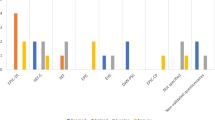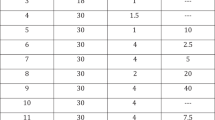Abstract
Baseline and follow-up data of 54 patients from a single surgical series (1998–2001), who used medicated urethral system for erection (MUSE) for the erectile dysfunction (ED) associated with radical prostatectomy (RP), were obtained. Patients were surveyed using the abridged five-item version of the International Index of Erectile Function (IIEF) questionnaire, commonly referred to as the Sexual Health Inventory of Men (SHIM), to determine presence and severity of ED and efficacy of ED treatment modalities. The mean patient age was 63.7±5.6 y and the mean follow-up period was 2.3±1.2 y. All patients experienced ED for at least 6 months after their surgery before starting MUSE therapy. Overall, 55% of the patients achieved and maintained erections sufficient for sexual intercourse while on MUSE and 48% continued long-term therapy with a mean use of 2.32±1.2 y. The mean presurgery SHIM score in these patients was 19.2±1.3, which decreased to 5.2±0.5 after surgery and increased to 16.3±1.3 after MUSE treatment. A total of 28 patients (52%) discontinued treatment after a mean use of 8±1.4 months. The reasons for discontinuation were insufficient erections (n=16, mean SHIM score of 10.5±4.4), switch to other ED therapies (n=4), natural return of erections (n=4) and urethral pain and burning (n=4). Excluding the patients (n=8) who preferred other therapies and return of natural erections, the compliance to MUSE was 63%. There were no significant differences in the IIEF-5 responses between the patients who had a nerve-sparing technique (n=34) and those who did not (n=20) or among patients who used different doses (250, 500 or 1000 μg) of MUSE. The results of the current trial indicate that MUSE is a successful treatment option in RP patients with established ED. It appears that a post-treatment SHIM score of ≥16 defines a successful outcome with MUSE therapy.
This is a preview of subscription content, access via your institution
Access options
Subscribe to this journal
Receive 8 print issues and online access
$259.00 per year
only $32.38 per issue
Buy this article
- Purchase on Springer Link
- Instant access to full article PDF
Prices may be subject to local taxes which are calculated during checkout
Similar content being viewed by others
References
Zippe CD et al. Management of erectile dysfunction following radical prostatectomy. Curr Urol Rep 2001; 2: 495–503.
Zippe CD et al. Role of viagra after radical prostatectomy. Urology 2000; 55: 241–245.
Wilke RJ et al. Quality of life effects of alprostadil therapy for erectile dysfunction. J Urol 1997; 157: 2124–2129.
Porst H . The rationale for prostaglandin E1 in erectile failure: a survey of worldwide experience. J Urol 1996; 155: 802–815.
Padma-Nathan H et al. Treatment of men with erectile dysfunction with transurethral alprostadil. N Engl J Med 1997; 336: 1–7.
Fulgham PF et al. Disappointing initial results with transurethral alprostadil for erectile dysfunction in a urology practice setting. J Urol 1998; 160: 2041–2046.
Costabile RA et al. Safety of transurethral alprostadil in patients with erectile dysfunction following radical prostatectomy. J Urol 1997; 157: 1424.
Montorsi F et al. Recovery of spontaneous erectile function after nerve sparing radical retropubic prostatectomy with and without early intracavernous injections of alprostadil: results of a prospective randomized trial. J Urol 1997; 161: 1914–1915.
Rosen RC et al. The International Index of Erectile Function (IIEF): A multidimensional scale for assessment of erectile dysfunction. Urology 1997; 49: 822.
Rosen RC et al Development and evaluation of an Abridged 5-Item version of the International Index of Erectile Function (IIEF-5) as a diagnostic tool for erectile dysfunction. Int J Impot Res 1999; 11: 319–326.
Porst H . Transurethral alprostadil with MUSE versus intracavernous alprostadil: a comparative study in 103 patients with erectile dysfunction. Int J Impot Res 1997; 9: 187–192.
Nehra A, Blute ML, Barrett DM, Moreland RB . Rationale for combination therapy of intraurethral prostaglandin E1 and sildenafil in the salvage of erectile dysfunction patients desiring noninvasive therapy. Int J Impot Res 2002; 14(Suppl 1): S38–S42.
Author information
Authors and Affiliations
Corresponding author
Rights and permissions
About this article
Cite this article
Raina, R., Agarwal, A., Ausmundson, S. et al. Long-term efficacy and compliance of MUSE for erectile dysfunction following radical prostatectomy: SHIM (IIEF-5) analysis. Int J Impot Res 17, 86–90 (2005). https://doi.org/10.1038/sj.ijir.3901284
Received:
Revised:
Accepted:
Published:
Issue Date:
DOI: https://doi.org/10.1038/sj.ijir.3901284
Keywords
This article is cited by
-
Men’s beliefs about treatment for erectile dysfunction—what influences treatment use? A systematic review
International Journal of Impotence Research (2021)
-
Current State of Penile Rehabilitation After Robotic Prostatectomy
Current Sexual Health Reports (2014)
-
Emerging concepts in erectile preservation following radical prostatectomy: a guide for clinicians
International Journal of Impotence Research (2011)



